Why do flying ants seem to arrive without warning, filling the air and crawling across patios in overwhelming numbers? Why do they seem to all emerge on the same day, and what does it mean when they do? The sudden appearance of flying ants often surprises and unsettles people, especially when they show up indoors.
But this phenomenon, often dubbed “Flying Ant Day,” has a clear explanation rooted in biology, weather patterns, and natural life cycles.
To understand why flying ants suddenly appear, it’s important to explore their purpose, their lifecycle, and what conditions lead to their dramatic mass emergence. Let’s delve into why these winged insects take to the skies each summer across the UK.
What Are Flying Ants?
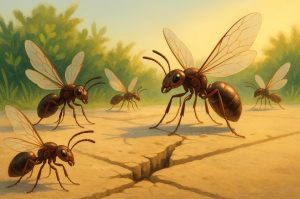
Flying ants are not a different species of ant, but rather a temporary reproductive stage in the life of certain ant colonies, especially the common black garden ant (Lasius niger).
These winged ants are known scientifically as alates, and they are the sexually mature males and virgin queens produced by the colony for the sole purpose of reproduction.
The ants that we normally see crawling along the ground or across our kitchen counters are sterile worker females.
However, once a colony reaches a certain size and maturity, typically a few years old, it begins producing a new generation of ants with wings, tasked with continuing the species.
The queens are noticeably larger than the males and workers, often reaching lengths of up to 15 millimetres. These winged ants are built for a single journey: to mate, disperse, and establish new colonies.
When Is Flying Ant Day in the UK?
Despite the widespread use of the term “Flying Ant Day,” the reality is that flying ants do not emerge on a single day across the country.
Instead, their appearance is spread out over several weeks, typically between June and early September, with July and August being peak months.
Scientific studies, including a citizen science project by the Royal Society of Biology, have confirmed that there are often multiple swarming events across the UK, depending on local weather conditions.
These swarming events are usually short-lived, lasting only a few hours to a couple of days in any given location.
The timing of these events is not arbitrary. Flying ants emerge when the weather conditions are ideal for flight and mating.
Warm, humid, and calm weather following a rainy spell often provides the necessary cues for colonies to initiate a mass release of winged ants.
Urban areas tend to see swarms earlier than rural ones, largely due to the urban heat island effect, where cities retain more heat than surrounding countryside.
Why Do Ants Suddenly Grow Wings and Fly?
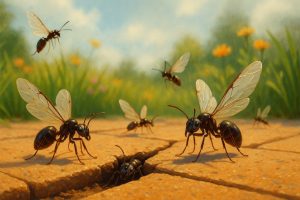
Ant colonies expand and sustain their populations by producing winged reproductive ants. The production of these winged forms begins when the colony is mature and well-established, often several years old.
Once this stage is reached, the queen begins laying eggs that develop into new queens and males.
Flying provides these reproductive ants with the ability to disperse and find mates from other colonies, avoiding inbreeding. This flight is known as the nuptial flight, and it allows fertilised queens to start new nests far from their original colony.
The ants take to the skies in synchronised swarms to maximise mating opportunities. Males and females from different nests are more likely to encounter each other in the air, mate, and then disperse across wider territories.
Why Do Flying Ants Swarm in Such Large Numbers?
The spectacle of thousands of ants swarming at once has evolutionary advantages. One of the main reasons for mass emergence is safety in numbers.
By appearing in overwhelming quantities, the ants reduce the risk of being eaten by predators such as birds and spiders.
Another reason for the large swarms is to increase the odds of successful mating. With many potential mates in the air at once, ants are more likely to find a partner, ensuring genetic diversity and the continuation of the colony’s lineage.
These nuptial flights are tightly synchronised within and across colonies, often happening on the same day or within a narrow window of time, depending on temperature, humidity, and barometric pressure.
What Happens After the Nuptial Flight?
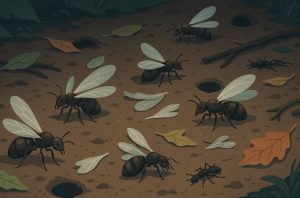
After the nuptial flight, the ants’ life paths diverge significantly based on their role. The male ants die shortly after mating, having fulfilled their biological purpose.
The new queens descend to the ground, chew off their wings, and begin searching for a suitable place to establish a new nest.
Once the queen finds a location, often in dry soil under pavements, patios, or garden beds, she digs a chamber and lays her first batch of eggs.
During this early stage, the queen does not eat; she relies on stored energy to survive until her first workers hatch and begin foraging.
The sperm she stores from the nuptial flight will last her entire reproductive life, enabling her to fertilise eggs for many years. Some Lasius niger queens live up to 15 years, with larger colonies housing up to 20,000 workers.
Where Do Flying Ants Come From?
In the weeks leading up to their swarming, you may notice small mounds of disturbed soil near patios, flower beds, or pathways. These are indicators of underground nests preparing for the release of winged ants.
Ants build nests in dry, sun-warmed soil, favouring locations such as:
- Gardens and lawns
- Cracks in pavements
- Brownfield sites and heathlands
- Beneath paving stones or concrete slabs
The nests can go unnoticed for most of the year, as worker ants carry out their foraging tasks with little disruption. It’s only during the flying ant season that these colonies reveal their reproductive castes.
Are Flying Ants Dangerous?
Flying ants are generally not dangerous. They do not bite or sting in most cases and pose no threat to humans or pets. Their appearance is temporary and part of a natural reproductive cycle.
However, some confusion arises due to carpenter ants, which can fly and also nest inside wooden structures. While carpenter ants don’t eat wood like termites, they can hollow it out to create nests, which may lead to structural damage over time.
Here’s a comparison to help distinguish between harmless flying ants and potential indoor threats:
| Characteristic | Flying Ants (e.g., Lasius niger) | Carpenter Ants |
| Nest Location | Outdoors, soil | Wood inside homes |
| Wing Appearance | Front wings longer than back | Same |
| Harm to Property | None | Can damage wood |
| Common in UK? | Yes | Less common |
| Aggressiveness | Low | Low to moderate |
If flying ants are frequently appearing indoors, especially during off-season periods, it may be time to investigate for infestation.
How Can You Get Rid of Flying Ants?
Most flying ant sightings require no action, as the insects disperse quickly after mating. However, if they swarm indoors or become a recurring issue, consider these control and prevention methods:
Short-Term Solutions
- Vacuum visible ants and discard the bag immediately.
- Use natural sprays such as peppermint oil mixed with dish soap to immobilise and kill flying ants on contact.
- Close windows and doors during peak hours to reduce indoor entry.
Long-Term Strategies
- Seal cracks and crevices around windows, doors, and foundations.
- Replace rotting wood and repair water-damaged areas to prevent carpenter ant nesting.
- Maintain cleanliness, especially in kitchens, to remove food attractants.
When dealing with persistent or indoor infestations, it may be necessary to consult a licensed pest control professional, especially if structural wood damage is suspected.
How Long Do Flying Ants Live?
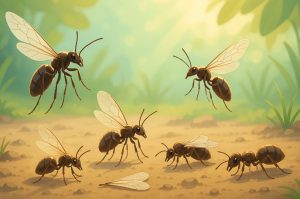
The lifespan of a flying ant depends on its role in the colony. Here’s a summary:
| Role | Lifespan |
| Males | 1 to 7 days (die post-mating) |
| New Queens | Up to 15 years (wild) |
| Worker Ants | Several months to 1 year |
Only a small portion of their lives is spent flying. Queens and workers will never fly again after the mating flight.
What Role Do Flying Ants Play in the Ecosystem?
Despite their nuisance factor, flying ants are an essential part of the ecosystem. Their short but dramatic appearance benefits several natural systems:
- Soil Aeration: Their tunnelling activity helps aerate and improve soil structure.
- Bird Diet: Swarms provide vital food for birds such as gulls and swifts.
- Butterfly Survival: Black garden ants protect the larvae of the silver-studded blue butterfly, aiding its survival in heathland habitats.
Ants also support biodiversity by creating underground habitats used by other insects and contributing to nutrient recycling.
Are All Flying Ants the Same Species?
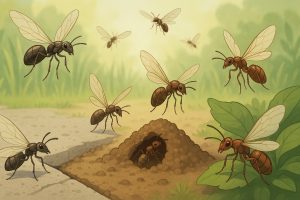
No. In the UK, the vast majority of flying ants are black garden ants (Lasius niger). However, other species also swarm, including:
- Myrmica rubra (Red ants)
- Lasius alienus (Cornfield ants)
- Wood ants (Common in forests)
Each species has its own preferred swarming time, triggered by slightly different temperature and humidity thresholds. This means you may encounter swarms at different times depending on your location and the local ant population.
Frequently Asked Questions
What causes flying ants to emerge all at once?
Flying ants swarm when weather conditions are ideal, warm, humid, and low-wind days following rain. These signals trigger synchronised nuptial flights.
Is there really a Flying Ant Day?
Not exactly. While it may appear all ants fly on one day, it’s actually part of a broader “flying ant season” lasting several weeks with multiple peaks.
Do flying ants bite or sting?
Generally, no. Most UK flying ants, especially Lasius niger, are harmless and do not bite humans.
Can flying ants damage my home?
Flying ants do not damage property, but carpenter ants and termites can. Persistent sightings may warrant professional inspection.
How can I prevent flying ants indoors?
Seal openings, repair decaying wood, and reduce indoor lighting during peak swarm times. Keep surfaces clean to reduce attractants.
Why do I see flying ants every year?
Flying ants are part of an annual reproduction cycle. Mature colonies produce winged ants each summer to propagate new nests.
Are flying ants attracted to light?
Yes. They are often drawn to indoor lighting, which is why they may enter homes during evening swarming events.
READ NEXT:






